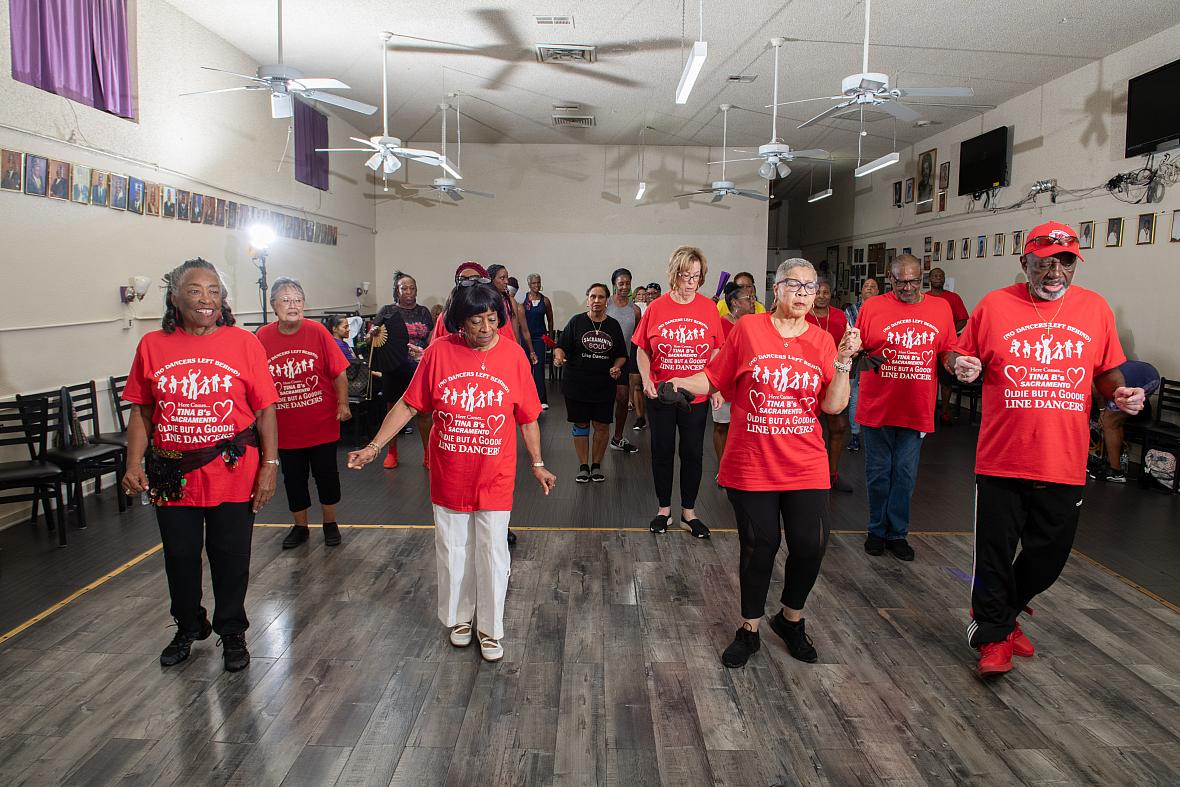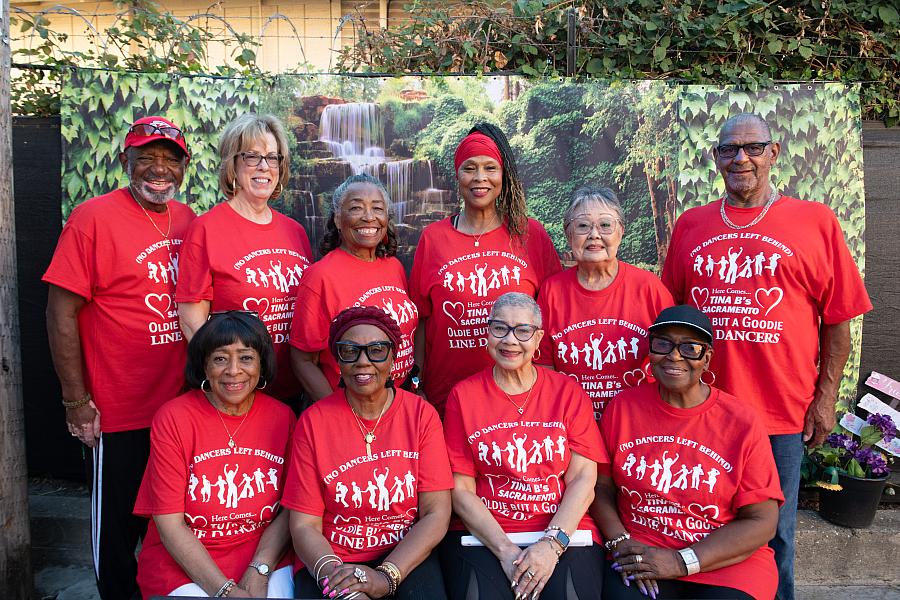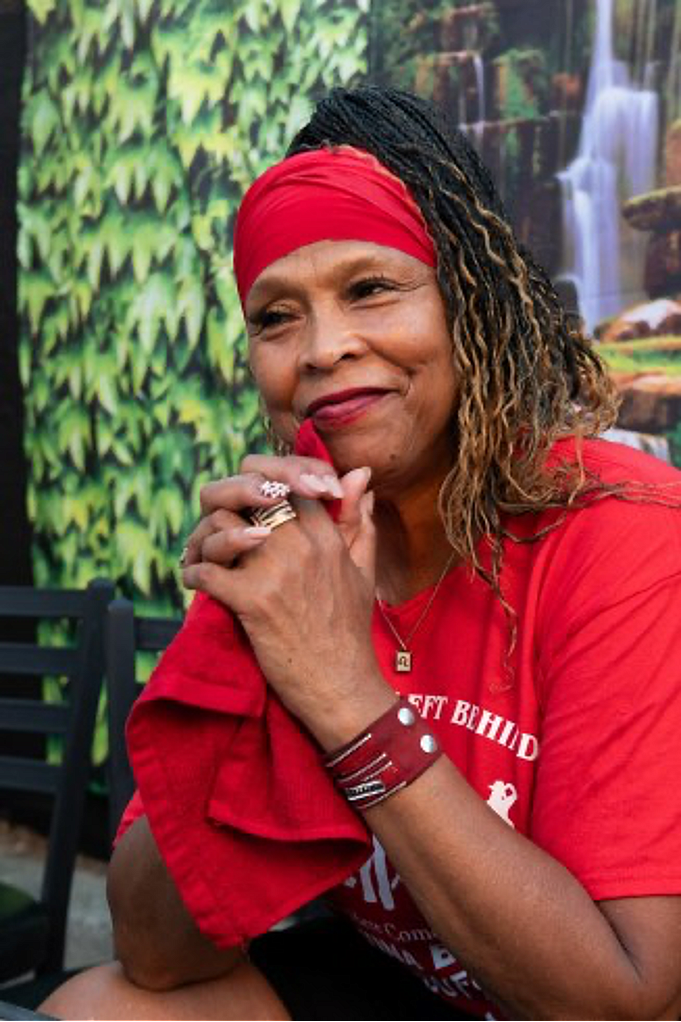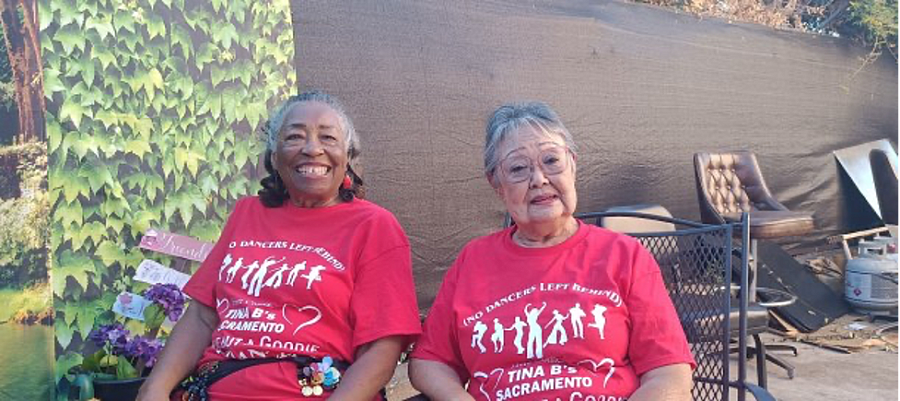Dancing For Their Lives—Black Seniors Find Vitality and Community Through Dance
The story was co-published with the Sacramento Observer as part of the 2024 Ethnic Media Collaborative, Healing California.

Line dancing at the Elks Lodge on Stockton Boulevard brings out adults of all ages.
Robert Maryland, SACRAMENTO OBSERVER
Getting on a crowded light rail train bound for Cosumnes River College, an older gentleman, aided by a cane, is offered a seat by a woman in her late 40s. The man declines, thanking the much younger woman for the show of respect, and explains why he refused her gesture.
“I’m 104 years old,” he says, adding cheekily, “And I’d like to stay on my feet.”
Staying active, even simply standing instead of sitting, is a part of the centenarian’s strategy for staying alive.
Motion is essential for seniors to maintain their overall health and well-being. Regular exercise can help improve cardiovascular health, strengthen muscles and bones, and reduce the risk of chronic diseases such as heart disease, stroke, and Type 2 diabetes. Additionally, physical activity can boost mood, enhance cognitive function, and improve sleep quality. A 2019 study published in the Journal of the American Medical Association found that regular exercise can help prevent cognitive decline in older adults. By incorporating physical activity into their daily routine, seniors can enjoy a healthier, happier, and more independent lifestyle.
California Department of Aging Director Susan DeMarois says policymakers have made the health and well-being of the state’s older residents a priority and are working to ensure seniors engage in physical activity.

Dancing is a safe social interaction for area seniors. Rita Ryans and J.D. Sanders, at right, married after meeting through line dancing classes.
Robert Maryland, SACRAMENTO OBSERVER
“California’s Master Plan for Aging guides policy for older adult services, embracing initiatives promoting health in our aging population and enhancing prospects for aging with dignity and independence,” DeMarois says. “Strategy C of Goal 1 focuses on outdoor and community living, highlighting the co-location of parks with community centers that offer programming for all ages, along with recommending park access to all within a 10-minute walk or less.”
CDA’s programs and services include activity and exercise classes such as those offered by California’s network of 33 Area Agencies on Aging and adult day programs at Community-Based Adult Services centers.
“There’s more than physical activity that’s important for older adults,” DeMarois adds. “Mental stimulation, a sense of community and connectedness, and interaction with others are critical to mental and physical health.”
Dance Fever

Local seniors have found fun and friendship through soul line dancing at the Elks Lodge on Stockton Boulevard. “Oldies But Goodies” include (back row): JD Sanders, 74; Diane Richardson, 75; Maryann Maryland, 82; instructor Tina Baltimore, 67; Karen Kwai Gonzales, 83; Joseph Guillory; 70; and (front row): Nell Gray, 80; LaSonya Jones, 77; Rita Ryans, 74; and Erma Walker, 80.
Robert Maryland, SACRAMENTO OBSERVER
In the Oak Park area, seniors line up at the Elks Lodge on Stockton Boulevard for classes led by Tina Baltimore of Tina B. and the Soul Line Dancers. Older dancers there are referred to as “oldies but goodies.”
Eighty-year-old Erma Walker has been line dancing with Baltimore for 13 years.
“It just seemed like it was going to be fun,” Walker says.
She has introduced several friends to the class over the years, but outlasted them all.
“I’m the one that hung in there,” Walker says.
Studies have shown that older adults who regularly dance have greater flexibility, postural stability, balance, physical reaction time, and cognitive performance than older adults who do not. Dance can be a highly beneficial form of exercise for sedentary seniors with pre-existing health conditions. It offers a low-impact, enjoyable way to improve physical fitness and overall well-being through improved cardiovascular health, enhanced balance and coordination, increased flexibility, boosted mood and cognitive function, and weight management.
In 2003, Albert Einstein College of Medicine neurologist and researcher Joe Verghese published a 21-year study in the New England Journal of Medicine, of participants over age 75, that showed dancing as the only physical activity associated with a lower risk of dementia. Known as the Bronx Aging Study, Verghese’s research found dancing increased blood flow to the brain and lowered stress levels, depression, and feelings of loneliness. Additionally, the act of memorizing steps and creating choreography with a partner was found to provide mental challenges vital for a healthy brain.
In 2016, researchers at the University of Pittsburgh and the University of Pennsylvania published findings from their Rhythm Experience and Africana Culture Trial (REACT!), which examined African dance as a form of moderate-intensity physical activity to improve cognitive function in African Americans age 65-75. Researchers called physical activity “a promising, low-cost method for improving neurocognitive function and reducing risk for dementia in older adults,” but found that “despite the known benefits of physical activity, few older adults actively and regularly engage in moderate-intensity activities.
Staying Alive

Tina Baltimore of Tina B. and the Soul Line Dancers took up the popular dance style to stay active and address chronic health issues that plagued her family. Today Baltimore gives others the space to do the same through a number of classes and workshops. Her motto is “No Dancers Left Behind.”
Robert Maryland, OBSERVER
Nell Gray, 80, was diagnosed with multiple sclerosis more than 30 years ago.
“I couldn’t walk,” she says of the chronic neurological disease that affects the brain and spinal cord.
“They tell you you’re not going to walk. [The doctor] actually told me if I didn’t take the medication, I was going to die. The doctors will tell you one thing, but you have to follow your own body and do what your body tells you to do. And that’s what I did.”
Gray declined medication for MS. She started line dancing in 2001.
“I struggled with it,” she admits. “I fell. I broke my shoulder because it was hard for me to move in general.”
She eventually was able to put her crutches down and go back to a cane.
“If I had just sat there doing nothing, I probably wouldn’t ever have walked. But I was determined. That’s why I went and line danced. No matter how many times I failed, I got back up again.
“I’ve been line dancing ever since. I’ve had two bouts of cancer,” she adds as further proof of her resilience. “I’m 80 years old and I’m doing well. God has kept me covered.”
For Bay Area native Joseph “Smokin’ Joe” Guillory, line dancing is a mental, physical and spiritual experience.
“It all works together,” Guillory says. “It helps the body and the mind.”
His laundry list of other procedures includes 10 knee surgeries and a gallbladder removal.
“I’m put together, really,” he says.
Guillory, 70, is a Vietnam War veteran who worked in construction for 38 years. Building refineries and nuclear facilities took a toll on his body and exposure to harmful materials left him with asbestosis.
“It went from my lungs – and I still have it – to my blood,” he says. “Then I had cancer. When you get cancer, the first thing you think is, ‘How long do I have?’”
Guillory had surgery for rectal cancer in 2018 and was still recovering when the coronavirus pandemic hit in 2020.
“It was really hard because there was nobody to associate with while I was going through this thing,” he says.
When the public was cleared to return to large gatherings and Baltimore could resume her classes, she invited Guillory to join. He enjoyed the Monday night sessions so much that he didn’t even mind foregoing his beloved televised football games.
“I haven’t missed a night in two years,” he says. “You meet a new crowd of people and these people aren’t judging you. They’re all there for the same thing: cardio. They call it line dancing, but a lot of people just feel like it’s a good exercise. When I leave here, I feel like I’ve got a workout. I feel good.”

Friends since pre-school, Maryann Maryland and Karen Kwai Gonzales are now in their 80s. They joined the line dancing class together to have something to do and stay active following a number of health issues in their older years.
Genoa Barrow, OBSERVER
Dancing is addicting, says Walker.
“But it’s a good addiction,” she says. “If I don’t go to line dance, I feel like I’ve missed something. It’s like if you don’t go to church, you feel like your day’s not right.”
LaSonya Jones, 77, has been dancing since childhood. In the 1990s, she was getting funky at another Oak Park spot, Touch of Class. Then her knees started popping and locking on their own. Knee replacements have slowed her, but she still comes to class every week and joins in.
“This was the best exercise from the other exercises I do for me,” she says. “I don’t ever want to be skinny like I was when I was young, but this keeps me toned.”
The classes also introduce her to a broader community.
“Having grown up in Sacramento and being born here, a lot of people that I knew have died off,” Jones says.
Jones’ husband is on dialysis and dancing gives her an outlet to still go out and have fun. She also looks forward to traveling with the group to dance conventions in Atlanta and New Orleans in 2025. Class founder Baltimore recently attended a masterclass in the Big Easy in July, learning new dances to bring back home.
You Got Served

Participants of the dance class at the Elks Lodge are supportive of one another and their varied abilities. Seniors like Nell Gray and Rita Ryans wear shirts with their names on the back.
Robert Maryland, OBSERVER
All abilities are welcome in Baltimore’s sessions at the Elks Lodge. There are no “foot police” in the room, she says.
“If we go left and you go right, it’s OK. Have fun,” she says. “Laugh at yourself because we all do it. Just be consistent. Come back. Dance at your comfort level.”
Repeat participants include lifelong friends Karen Kwai Gonzales and Maryann Maryland, who both turn 83 in September and October respectively.
“I didn’t know anything about line dancing, but it’s so much fun,” Gonzales says. “And they treat me like family.”
After having her thyroid removed, dancing gives Gonzales more energy. Maryland likes being able to go at her own pace, having had a knee replacement and several rotator cuff surgeries.
While she can “shake a little something,” she didn’t have much experience when they first started the class.
“We did not dance very well at all,” Maryland says.
The instructors and other dancers were welcoming and encouraging. The Monday night classes at the Elks Lodge help her decompress from the rigors of helping an adult son care for her ex-husband, who is living with dementia and diminished faculties.
Maryland, Gonzales, and the others proudly don red T-shirts that signify their “oldies but goodies” status. The seniors recently performed at the California State Fair.
“I deal with physical problems, but I keep coming,” says Rita Ryans, 74. “You just keep going.”
When one of Baltimore’s dancers was diagnosed with breast cancer, she asked if there was anything she could do for her.
“She said, ‘Don’t stop this class.’”
Over the years, Baltimore has used dance to promote better health outcomes for African Americans, performing at local breast cancer awareness events and volunteering with the American Heart Association’s campaign against strokes. Having come from a background where relatives drank and used illegal substances, Baltimore decided to lead by example.
“I knew that I had to get on a healthier mission for myself because of my family history – diabetes, obesity, breast cancer, alcoholism – all that,” she says. “I eat healthier. I have a daughter, she has kids, so I need to do something to be around for my kids and my grandkids. And now I’ve got great-grandkids. I wanted to come out and say, ‘Wait a minute. I can make a difference in my own family.’”
EDITOR’s NOTE: This article is part of OBSERVER Senior Staff Writer Genoa Barrow’s series, “Senior Moments: Aging While Black.” The series is being supported by the USC Annenberg Center for Health Journalism and is part of “Healing California,” a yearlong reporting Ethnic Media Collaborative venture with print, online and broadcast outlets across California. The OBSERVER is among the collaborative’s inaugural participants.

